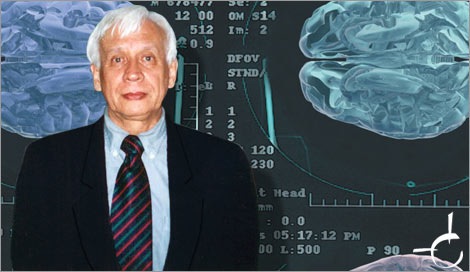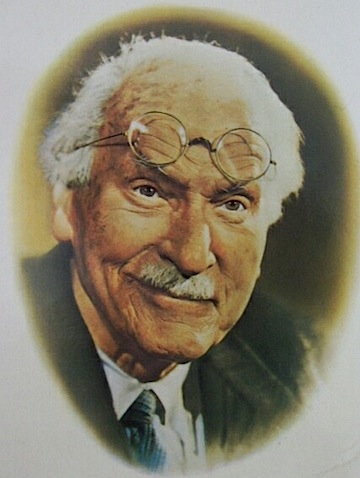Thoughts About the Brain

“Basically there are two types of animals: animals, and animals that have no brains; they are called plants. They don’t need a nervous system because they don’t move actively, they don’t pull up their roots and run in a forest fire! Anything that moves actively requires a nervous system; otherwise it would come to a quick death.”
–Rodolfo Llinas (Colombian-born Neuroscientist and Thomas and Suzanne Murphy Professor of Neuroscience and Chairman of the department of Physiology & Neuroscience at the New York University, 1934-)
Your Brain

“Overall, the human brain is the most complex object known in the universe — known, that is, to itself.”
–Edward O. Wilson (American Biologist, Leading Authority on Ants, and Proponent of Sociobiology, 1929-)

“Consilience: The Unity of Knowledge” (Edward Osborne Wilson)
Separating the Psyche and the Brain

“We must completely give up the idea of the psyche’s being somehow connected with the brain.”
–Carl G. Jung (Swiss Psychologist and Psychiatrist, 1875-1961)
A Busy Brain

“My own brain is to me the most unaccountable of machinery-always buzzing, humming, soaring, roaring, diving, and then buried in mud. And why? What’s this passion for?”
–Virginia Woolf (English Writer, 1882-1941)
The Mystery of the Brain

“As long as our brain is a mystery, the universe, the reflection of the structure of the brain will also be a mystery.”
–Santiago Ramon y Cajal (Spanish Anatomist and, in 1906, Winner of the Nobel Prize for Medicine, 1852-1934)
Jazz and the Brain

It is remarkable how good the brain is at coordinating multiple regions at once. A new study published in today’s issue of the journal Public Library of Science (PLoS) One has used functional magnetic resonance scanning (fMRI) to examine musicians engaged in highly creative and spontaneous jazz improvisation. They found that a large region of the brain involved in monitoring one’s performance is shut down, while a small region involved in organizing self-initiated thoughts and behaviors is highly activated. The researchers propose that this and several related patterns are likely to be key indicators of a brain that is engaged in highly creative thought.
During the study, six highly trained jazz musicians played keyboard under two conditions. In the first scenario, called the Scale paradigm, the music was based on a simple C major scale. Using only their right hand, the volunteers first played the scale up and down in quarter notes. Next, they were asked to improvise, though they were limited to playing quarter notes within the C major scale.
The second scenario, called the Jazz paradigm, examined higher-level musical improvisation. This paradigm was based on a novel blues melody that the volunteers had memorized beforehand, and had been written by one of the researchers. Again, using only their right hand, the musicians played the tune exactly as they had memorized it, only this time accompanied through headphones by a pre-recorded jazz quartet. When they were asked to improvise, the musicians listened to the same audio background, but they were free to spontaneously play whatever notes they wished.
The brain scans were nearly identical for the low-level and high-level forms of improvisation, supporting the idea that the change in neural activity was due to creativity and not the complexity of the task.
Much of the change between improvisation and memorization occurred in the prefrontal cortex, the region of the frontal lobe of the brain that helps us think and problem-solve. It is also involved in generating the sense of self. The dorsolateral prefrontal cortex is responsible for monitoring our own performance and it shuts down completely during improvisation, while the much smaller, centrally located region at the foremost part of the brain – the medial prefrontal cortex – increases in activity. The medial prefrontal cortex is believed to be involved in self-initiated thoughts and behaviors, and it becomes very active when a person describes an event that has happened to him or makes up a story.
The suppression of inhibitory, self-monitoring brain mechanisms helps to promote the free flow of novel ideas and impulses. This is an unusual pattern of brain activity that closely resembles the pattern seen in people when they are dreaming.
Another unusual finding was that there was increased neural activity in each of the sensory areas during improvisation, including those responsible for touch, hearing and vision, despite the fact that there were no significant differences in what individuals were hearing, touching and seeing during both memorized and improvised conditions. This suggests that when the brain wants to be creative, a whole range of sensorimotor processing is increased. At the same time systems that regulate emotion were also engaged during improvisation.
As someone who has done a lot of brain imaging, and has spent many hours inside scanners, this whole piece of work is dazzling from a technical point of view. The hardy musicians had to lie on their backs with their heads and torsos inside the scanner and their knees bent upward. They had to use a plastic keyboard, which was shortened to fit inside the scanner and which rested on their knees. A mirror placed over the volunteers’ eyes, together with the headphones, helped the musicians see and hear what they were playing.
Just thinking about it makes me queasy.
“Words are the children of reason and, therefore, can’t explain it. They really can’t translate feeling because they’re not part of it. That’s why it bugs me when people try to analyze jazz as an intellectual theorem. It’s not. It’s feeling.”
–Bill Evans (American Jazz Pianist, 1929-1980)
“Jazz tickles your muscles, symphonies stretch your soul.”
–Paul Whiteman (American Musician and Bandleader, called the King of Jazz for popularizing a musical style that helped to introduce jazz to mainstream audiences during the 1920s and 1930s, 1890-1967)
“Jazz music is an intensified feeling of nonchalance.”
–Françoise Sagan (French Novelist and Dramatist, 1935-2004)
Violence and Diet
We have talked before about the link between nutrition and violence.
The evidence has continued to mount and I was pleased to see that the Wellcome Trust is funding trials in three British prisons to investigate the link between nutrition and behavior. This is a placebo study that will examine which nutrients are most important and at what dosage.
Volunteers from three young offenders institutions housing male prisoners aged 16 to 21 will take nutritional supplements in addition to their normal choice of food to ensure they receive the necessary vitamins, minerals and essential fatty acids to meet daily guidelines. The investigators will monitor how levels of nutrients affect a range of behaviors including violence, drug-related offences and incidents of self-harm.
The new trials build on previous research published in the British Journal of Psychiatry that was conducted at the then maximum security Young Offenders Institution in Aylesbury, Buckinghamshire. That study was funded by Natural Justice, a research charity that investigates the social and physical causes of offending behavior. Nutritional supplements – 2 grams per day of the omega-3 fatty acids EPA and DHA for three months – were given to ensure that inmates’ diets reached recommended UK dietary standards. The researchers found that the prisoners who consumed the active nutrient capsule committed on average 26% fewer disciplinary offenses overall than those taking the placebo and 37% fewer violent offenses.
The most likely reason why supplements can have such a large effect is because the proper functioning of nerve cell membranes and signaling molecules depends upon adequate amounts of minerals, vitamins and essential fatty acids in the diet.
This is extremely important work. Clearly nutrition is not the only driver of violence but it has been wondered for a long time whether the industrialization of our diets has contributed to the enormous rise in violent crime between the 1950s and 1970s.
“Violence is the last resort of the incompetent.”
Isaac Asimov (Russian-born American Biochemist and Writer, 1920-1992)
“Blessings crown the head of the righteous, but violence overwhelms the mouth of the wicked.”
–The Bible (Proverbs 10:6)
“Peace cannot be achieved through violence, it can only be attained through understanding.”
–Ralph Waldo Emerson (American Poet and Essayist, 1803-1882)
Judah Folkman R.I.P.

I just heard that Judah Folkman just passed away at the age of 74. That is a name that is not widely known outside the scientific world, although a couple of years ago an excellent book –Dr. Folkman’s War – was written about him and his work.
His major work and his enduring legacy was in the field of angiogenesis: the production of new blood vessels. In the 1960s he came up with the idea that a way to kill tumors was to starve them of the blood supply that they need to survive. He was initially ridiculed, but history is now proving him correct. I got to know him twenty years ago after publishing a paper in which I described the discovery of a growth factor that is involved in the production of new blood vessels at the back of the eye in people with diabetes. Judah was very supportive and we had many good discussions about the potential role of angiogenesis not only in tumors and diabetic retinopathy, but also in diseases like rheumatoid arthritis and psoriasis.
Last November, at the 12th Annual Society for Neuro-Oncology Meeting in Dallas, researchers from the University of Virginia and several other leading brain tumor centers in the United States presented data on the successful use of an inhibitor of angiogenesis in the treatment of glioblastoma multiforme (GBM), the most common form of primary brain cancer. It is hard to treat, and if it recurred after surgery, radiation and/or chemotherapy there was often not much to be done.
Building on Judah’s work, they wanted to see if they could inhibit vascular endothelial growth factor (VEGF) that has an important role in the disease. VEGF fosters the growth of a tumor by
stimulating the growth of new blood vessels to feed it. According to earlier studies, bevacizumab (BV) (Avastatin), a humanized monoclonal antibody that specifically targets VEGF, in combination with irinotecan (also called CPT-11) could have a role in recurrent glioblastoma multiforme. The researcher was an attempt to establish the clinical benefit of BV, both alone and in combination with CPT-11, in a multicenter, randomized phase II trial.
The results were very promising, substantially exceeded the pre-specified thresholds set for this work.
They looked at 6-month progression-free survival (PFS) defined as no clinical or MRI tumor growth and the objective response rate (ORR), which measures tumor shrinkage. Secondary endpoints included safety and survival. Response assessments were conducted by an independent radiographic facility that did not know which patients had been treated. All patients were followed for 24 weeks to determine efficacy and safety.
When taking BV, 35.6 percent of patients on average had a 6-month survival with no progression of their cancer, and an objective response rate of 21.2 percent on average.
The combination of BV and CPT was even more effective, with results of 51 percent and 34.1 percent, respectively.
The investigator group found similar results when they evaluated the patients. Those results showed that 44.7 percent of patients on average had a 6-month survival with no progression of their cancer, and an objective response rate of 38.8 percent on average. The combination therapy yielded results of 60.9 percent and 46.3 percent, respectively.
The surviving patients have remained in the study and are still being treated and followed, so we shall be seeing some longer-term results in the future.
In the United States bevacizumab has already been approved for the treatment of metastatic colon cancer and most forms of metastatic non-small cell lung cancer.
This is very encouraging research and a fitting tribute to a genuine medical pioneer.
Music, Language and the Brain

For more than two centuries neurologists and others interested in music and language have wondered whether or not language and music depend on common processes in the mind. It has been known that some aspects of language and music are represented in different regions of the brain, but there are also many areas of crossover.
Now, researchers at Georgetown University Medical Center have published evidence in the journal NeuroImage, that the processing of music and language do indeed depend on some of the same brain systems.
Their findings suggest that two different aspects of both music and language depend on the same two memory systems in the brain. One brain system, based in the temporal lobes, helps us to memorize information in both language and music, for example words and meanings in language and familiar melodies in music. The other memory system is focused in the frontal lobes, and this one helps us to learn “unconsciously” and use the rules that underlie both language and music, such as the rules of syntax in sentences, and the rules of harmony in music.
The study involved 64 adults and the researchers used a technique called event-related potentials, in which they measured the brain’s electrical activity using electrodes placed on the scalp.
The subjects listened to 180 snippets of melodies. Half of the melodies were segments from tunes that most participants would know, such as “Three Blind Mice” and “Twinkle, Twinkle Little Star.” The other half included novel tunes composed by one of the researchers. Three versions of each well-known and novel melody were created: melodies containing an in-key deviant note that could only be detected if the melody was familiar, and therefore memorized; melodies that contained an out-of-key deviant note that violated rules of harmony; the original melodies that acted as the “controls”
They found that violations of rules and memory in music corresponded to the two patterns of brain waves seen in previous studies of rule and memory violations in language. In-key violations of familiar melodies led to a brain-wave pattern similar to one called an “N400” that has previously been found with violations of words. One example that the authors gave: :I’ll have my coffee with milk and concrete.” Out-of-key violations of both familiar and novel melodies generated electrical activity over the frontal lobe similar to the patterns previously found for violations of rules in both language and music. Out-of-key violations of familiar melodies also led to an N400-like pattern of brain activity, as expected because these are violations of memory as well as rules.
This research opens up new ways of thinking about the relationships between language and music, and may have implications for speech and language therapy.
“When I hear music, I fear no danger. I am invulnerable. I see no foe. I am related to the earliest times, and to the latest.”
–Henry David Thoreau (American Essayist and Philosopher, 1817-1862)
“There is nothing better than music as a means for uplifting the soul.”
–Hazrat Inayat Khan (Founder of the Sufi Order of the West, 1882-1927)
“There are more love songs than anything else. If songs could make you do something we’d all love one another.”
–Frank Zappa (American Composer, Guitarist, Satirist and Song Writer, 1940-1993)
“Since music is a language with some meaning at least for the immense majority of mankind, although only a tiny minority of people are capable of formulating a meaning in it, and since it is the only language with the contradictory attributes of being at once intelligible and untranslatable, the musical creator is a being comparable to the gods, and music itself the supreme mystery of the science of man, a mystery that all the various disciplines come up against and which holds the key to their progress.”
–Claude Lévi-Strauss (Belgian-born French Social Anthropologist, 1908-)
Brain Mapping and ADHD

It is amazing how many people remain resistant to the idea that Attention Deficit Hyperactivity Disorder (ADHD) is a genuine problem. It is likely becoming more common as we live in a progressively more demanding world in which our inner resources can easily become overwhelmed. It is a “real” problem since if it is severe it can cause suffering and second, ADHD can also be associated with a range of other difficulties. There is also more and more evidence that it is associated with robust disturbances in the structure and functioning of the brain.
There is an important study published in Human Brain Mapping that reveals an association between ADHD and a decrease in cortical volume, surface area and folding throughout the brain. Researchers from the Kennedy Krieger Institute in Baltimore, Maryland, found that children with ADHD has decreased total brain volume and decreased volume throughout the cerebral cortex. What is new is that the reduction in cortical volume seems to be the result of decreased folding in the cortex. This in turn suggests that folding – a process that starts around the 14th-16th weeks of pregnancy and continues into infancy – is the key structural brain feature associated with ADHD.
The investigators examined 21 children with ADHD aged 8-12 years, and a control group of 35 unaffected children matched for age and gender. The children with ADHD had more than 7 percent reduction in total cerebral volume compared with the control group.
One of the design problems in human beings is that the brain is encased in a hard skull that moves little. So once the brain has grown to fill the skull, the only way to increase the surface area of the brain is for the cortex to become more folded. The whole process of cortical folding is crucial to increasing the structural and functional capacity of the brain.
This is of great interest, particularly in light of the study just published in the Proceedings of the National Academies of Sciences that indicates that the brain of people with ADHD can catch up later. That study did not look at brain folding, so it will be interesting to see exactly how the brain can catch up, and how we might be able to give it a helping hand.







